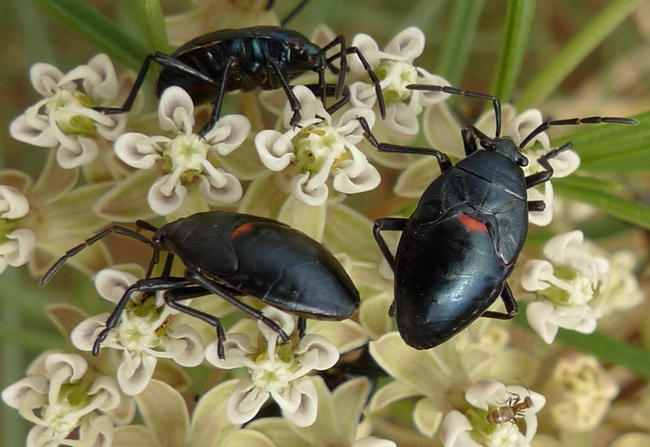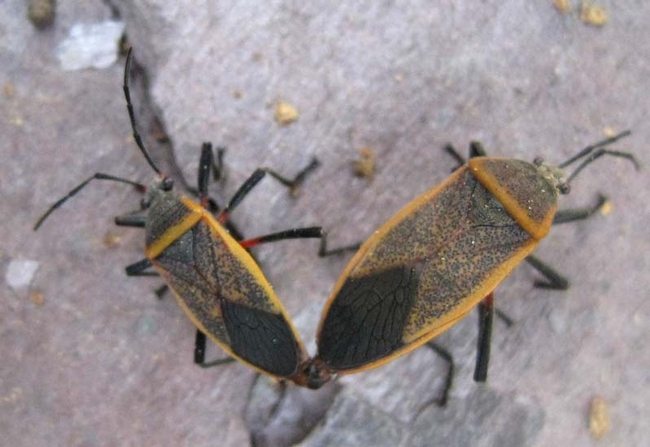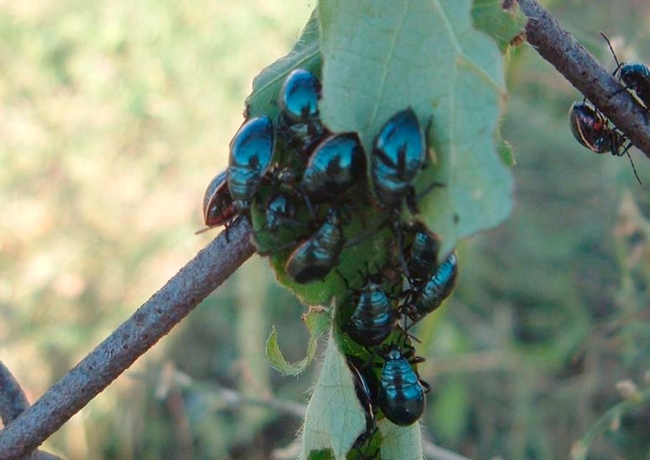- Author: Scott Oneto
- Author: Rebecca Miller-Cripps

The identification of all these various insects is the same. It is the bordered plant bug (Largus succinctus or Largus sp.) The adult is pretty easy to identify, but the immature nymphs can sometimes be a bit more difficult, as they don’t look anything like the adults. The nymphs (immature stage) lack fully developed wings. Their color is metalic blue/black with an orange, warning triangle at center.
Bordered plant bugs feed using piercing-sucking mouthparts and are classified as true bugs, order Heteroptera. As such, their food consists entirely of liquid extracted from plant tissues. Their feeding is concentrated on the most nutritious parts of plants such as flowers and fruit. In most cases no control is needed as the insects often move on late in the summer and don’t cause significant harm to ornamental plants. In the food garden, the insects can cause damage by scarring developing fruits, such as strawberries and blueberries. In this case, hand removal is easy by knocking insects into a mason jar, vacuuming them up using a shop vac, or stepping on them. No chemical control is recommended.
If you would like to read more about bordered plant bugs, see the UC Statewide Integrated Pest Management Program's pest note on box elder bugs. Although not the same insect, they are similar and the biology and control are similar






I have seen them mistakenly referred to as boxelder bugs even on the IPM website, but didn't bother poiting it out, since, like you said, they are closely related and the management is the same.
I found that the key to reducing their numbers is to kill the first ones that you notice emerging in early spring, as they are the mothers (or fathers...) of the thousands that follow otherwise.
I wonder if you have squash bugs, not bordered plant bugs. The squash bug, Anasa tristis, is a common pest of all cucurbit crops, especially squash and pumpkins. They also have orange edging around their abdomens and they feed on cucurbit leaves. Young squash bugs look very aphid-like. Go to http://www.ipm.ucdavis.edu/PMG/PESTNOTES/pn74144.html for more information.
Rebecca miller-Cripps
Lygus bugs, stink bugs, boxelder bugs and bordered plant bugs all use plant hosts in addition to fruit trees for feeding, reproduction, and overwintering. Most potential problems can be reduced by appropriately managing or removing the
alternate hosts. These bugs feed primarily on broadleaf weeds in the orchard ground cover, on borders, or in nearby crop fields, especially alfalfa. To keep populations from building up in the orchard, it is best to plant a ground cover that will discourage encroaching weed hosts. Perennial grasses or other herbaceous cover crops that do not harbor plant bug pests are recommended. Proper ground cover management is especially critical in peach and nectarine orchards where cat-facing injury can be severe. Dry vegetation, mowing, herbicide treatment, and cultivation can all cause bugs in the ground cover to move into trees in search of alternate food. Avoid mowing, cultivation, and herbicide application during periods when bug
populations are high and fruit is most susceptible to injury, such as during bloom, when fruit is young, and near fruit
maturity. Remove weed hosts on orchard borders where possible and avoid planting alfalfa next to orchards.
Such measures will help reduce the number of adults migrating into orchards during spring and summer. For orchards that suffer annual boxelder bug damage, removing host trees, such as female boxelder, maple, and ash, from the surrounding area can help reduce boxelder bug populations. However, this is often impractical for orchards that are adjacent to uncultivated areas with abundant boxelder stands, or near urban areas where host trees are in the landscape.
I made the mistake of tolerating them, and now they seem to be ubiquitous in the yard, everywhere, just everywhere. Time to corral them little critters, as much as I hate to.
http://ipm.ucanr.edu/PMG/PESTNOTES/pn74114.html
https://www.xerces.org/wp-content/uploads/2016/10/Habitat-Planning-Beneficial-Insects_Feb2017_web.pdf
The only thing I have found that helps mitigate the damage is to keep the ground clear around the plants and trees and regularly check (daily) to clean off those that have gathered. I completely removed all the strawberries because this was just the perfect a breading ground for them. I would and have found thousands of nymphs gathered in the cover of the strawberries.
Hosing down the plant daily just doesn't make sense like those mentioned, due to the issues this would cause. I might try diatomaceous earth this year again as deterrent, but in the past it had mixed reviews in my experience. I would really like to have those who think they are trivial come see the damage they can do and take this more seriously. I don't want to spray but would be extremely interested in an effective way to reduce their numbers.
Would white wine vinegar or other natural, organic mixture have any kind of deterrent effect?